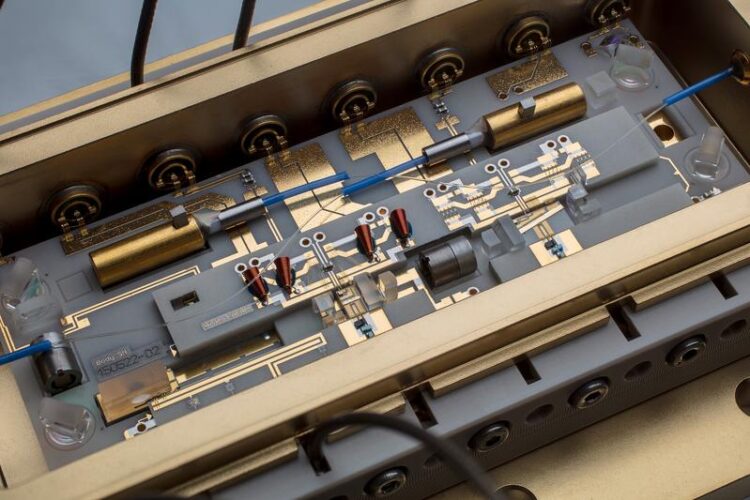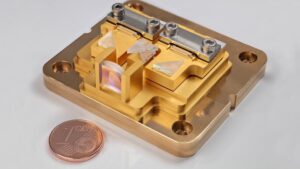Reliable semiconductors for space, satellites, and quantum technologies

Compact and robust high-power laser module developed for high-end quantum optical applications in space. 55 of such modules are being delivered for the joint DLR/NASA BECCAL facility on the ISS.
© FBH/schurian.com
The Ferdinand-Braun-Institut exhibits space-qualified diode laser modules with narrow linewidth and optical frequency references for satellite and quantum technology applications at “Space Tech Expo Europe” in Bremen.
From November 15-17, 2022, the Ferdinand-Braun-Institut (FBH) will present its developments at the Berlin-Brandenburg joint stand in hall 6, R36. The Berlin-based research institute has many years of comprehensive experience in developing III-V semiconductor-based devices and subsystems for space and satellite-based applications along with the relevant technologies. It covers the entire value chain in-house – from chip design and processing to microintegrated modules and systems. FBH cooperates closely with international partners from research and industry, including projects funded by the European Space Agency (ESA) and the German Aerospace Center (DLR).
Laser modules for satellites: from communications to climate protection

© FBH/schurian.com
FBH has been developing pump lasers for satellite applications for many years. Laser diode benches (LDB) of the institute are successfully used, among others, in Tesat-Spacecom’s laser communication terminals (LCT). With them, high data volumes originating from Earth observation can be transmitted exceptionally fast between satellites and to Earth. The wavelength of the LDBs is stabilized exactly to the pump wavelength of the Nd:YAG laser and ensures stable LCT performance. The LDBs are designed and qualified according to ESA standards for space applications. They feature excellent reliability over the entire mission lifetime of 15 years.
FBH has also developed, qualified and supplied pump lasers for the MERLIN climate satellite, which will be measuring the methane concentration in the atmosphere. The modules are each equipped with two high-power laser half-bars delivering 130 W optical power at 808 nm in pulsed mode. The performance and reliability over the entire mission duration has been demonstrated by extensive technology qualifications and confirmed by ESA’s Technology Center ESTEC.
For future space missions, FBH has additionally developed a novel DBR laser array module. Thanks to an integrated chip-level Bragg reflector, it offers both low noise and high reliability. The suitability for continuous operation of more than 15 years has also been demonstrated for these modules.
Laser systems for quantum-optical precision experiments & frequency references
Compact diode lasers and robust laser modules from FBH have been successfully used several times in sophisticated experiments under microgravity conditions. Among others, FBH is currently manufacturing 55 narrow-band laser modules developed for the BECCAL (Bose-Einstein Condensate – Cold Atom Laboratory) apparatus. They are to be used for quantum optical experiments with ultra-cold atoms on board the International Space Station ISS.
Core components of the modules are laser diodes developed at the institute, which are assembled together with optics and further passive elements with highest stability and precision. FBH’s unique microintegration technology makes the modules extremely robust and ideally suited for use in space. In addition, the modules feature excellent parameters in terms of size, weight and performance: they deliver 500 mW in a single-mode fiber at > 20 % conversion efficiency (electrical to optical) and offer a low intrinsic linewidth < 1 kHz. The laser modules can be flexibly realized in the wavelength range from 630 nm to 1180 nm. Due to the increased demand for modules and subsystems with a variety of integrated functionalities, FBH is currently expanding its activities into an “Aerospace Competence Center”. The institute is thus expanding its know-how and capacities in the development and production of subsystems and small series.
In close collaboration with Humboldt-Universität zu Berlin, such modules are also being built into compact quantum sensors and optical frequency references (OFR) for use in space. The Joint Lab demonstrated an autonomous frequency reference based on the D2 transition in rubidium. It achieved a 1 second instability of 1.4 x 10-12 within a volume of only about 400 ml. Such OFRs are promising candidates for global navigation satellite systems such as GPS. In addition, they are used in optical calibration and as absolute references in atom-based quantum technology.
Media Contact
All latest news from the category: Physics and Astronomy
This area deals with the fundamental laws and building blocks of nature and how they interact, the properties and the behavior of matter, and research into space and time and their structures.
innovations-report provides in-depth reports and articles on subjects such as astrophysics, laser technologies, nuclear, quantum, particle and solid-state physics, nanotechnologies, planetary research and findings (Mars, Venus) and developments related to the Hubble Telescope.
Newest articles

Innovative 3D printed scaffolds offer new hope for bone healing
Researchers at the Institute for Bioengineering of Catalonia have developed novel 3D printed PLA-CaP scaffolds that promote blood vessel formation, ensuring better healing and regeneration of bone tissue. Bone is…

The surprising role of gut infection in Alzheimer’s disease
ASU- and Banner Alzheimer’s Institute-led study implicates link between a common virus and the disease, which travels from the gut to the brain and may be a target for antiviral…

Molecular gardening: New enzymes discovered for protein modification pruning
How deubiquitinases USP53 and USP54 cleave long polyubiquitin chains and how the former is linked to liver disease in children. Deubiquitinases (DUBs) are enzymes used by cells to trim protein…


